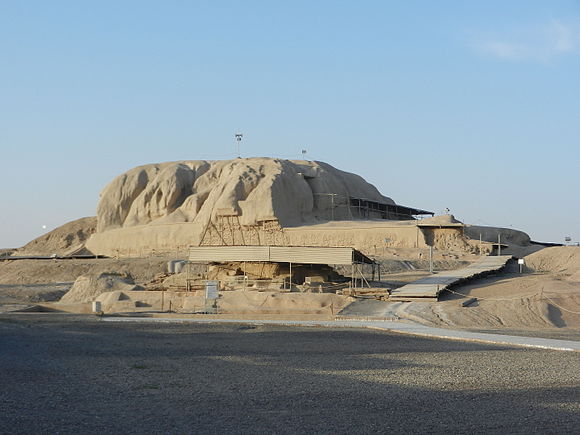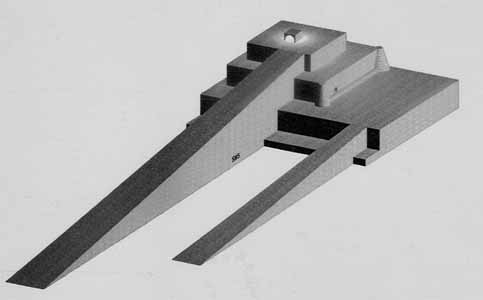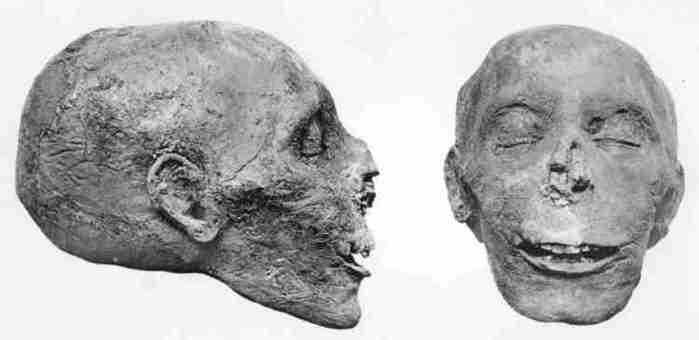Dating to 8th-7th millenniums, more than 60 skulls since the 1950's have been found in the Levant, usually buried under the floor of homes, that were uniquely covered in plaster and filled in with soil in which the the faces were painted and adorned to recreate the face. The most famous collection of skulls were discovered in the ancient city of Jericho, dated to c. 7,500BC, with evidence of occupation going back at least 12,000yrs. Many (all?) of these skulls showed various forms of elongation:
Image may be NSFW.
Clik here to view.
Skulls of Jericho:
Image may be NSFW.
Clik here to view.
One in particular, the famed "Jericho man", was recently digitally reconstructed:
Image may be NSFW.
Clik here to view.
Image may be NSFW.
Clik here to view.
Quite a strange looking fellow with noticeably elongated skull akin to the "Ubaid" type I have spoken of before. Scientists assume these skulls were "probably" artificially deformed but as I have argued this is not always the case.
Below is a collection of previous posts regarding this general subject of Near East/Egyptian elongated skulls that are worthwhile to present here. If I have the time I will collect other posts as well of more finds I have written about. The short of it is the elongated skull phenomenon in the Near East is real spanning several thousand years. To walk the streets of early Levantine, Mesopotamian, and Elamite cities, even Egypt, would have been bizarre filled with many odd looking people.
_________________________________________________________________________________________________________________________
Image may be NSFW.
Clik here to view.
Ancient Long-Headed Skull from Korea was Naturally Formed
Research paper:
Bio-Anthropological Studies on Human Skeletons from the 6th Century Tomb of Ancient Silla Kingdom in South Korea.
_________________________________________________________________________________________________________________________
Skeleton of 7,500-Year-Old Man Found Almost Intact in Iran
Image may be NSFW.
Clik here to view.
While the article doesn't note the obvious elongated skull, such "long-headed" skulls are common in ancient Iran. Though elongated skulls of various types have been found in the greater Mesopotamian region spanning thousands of years well into the historical period, dating back to at least the 9th millennium BC, in Iran alone, some of the oldest, dozens of "long-headed" type elongated skulls have been excavated from just 18 sites dated to the 8th-5th millenniums:
PREHISTORY OF IRAN: ARTIFICIAL CRANIAL MODIFICATIONS
Different in appearance than those commonly associated with the Ubaid of Mesopotamia from the same period:
Ubaid Headshaping.p125-142.
While the Ubaid type of elongated skulls may have been artificially deformed (though probably not all), despite the fact the Iran article insists these too are all "artificial", the "long-headed type", there is a growing body of scientific study that is proving that at least with some types of elongated skulls, like the long-headed type pictured above from Korea as well as those found in the Amarna period in Egypt, are in fact natural. I would suggest that many of the ancient elongated skulls cataloged as being caused by artificial cranial deformation were uncritically done so based on assumptions derived from similar but different modern examples and believe that for these skulls to be scientifically re-examined using modern methods that many would in fact prove to be natural as well.
_________________________________________________________________________________________________________________________
Along with the Anu ziggurat of Uruk, the mud brick Sialk Ziggurat of Iran is considered the oldest in the world dating to c. 3,000BC with occupation of the site going back to at least c. 5500-6,000BC.
Image may be NSFW.
Clik here to view.
Proposed reconstructions:
Image may be NSFW.
Clik here to view.
Another.
Dating to the earliest periods, several skull types are found including several what I call "Cro-Magnoid" (hyperdilochocephalic) skulls as well as the less extreme more rounded "Ubaid-type" spoken of before.
Regarding the remains found at Sialk:
The Development of Cities.
10yr old girl c. 5500BC:
Image may be NSFW.
Clik here to view.![]()
LARGE
While elongated skulls of various types as we know have been found all over the world well into AD times, much more than people realize, the fact of the matter is that apparently beginning in the 9th millennium, most notably from the 6th millennium onward, the greater Mesopotamia region in particular (including the Levant and Anatolia) was a very strange place filled with large numbers of rather unusual looking people. These are not an accumulation of unique instances, but rather the norm found ubiquitously across thousands of years of Mesopotamian culture, eventually bleeding into Egypt during the later predynastic period, which all told represents nothing short of a phenomenon.
_________________________________________________________________________________________________________________________
NW Anatolia (Turkey) c. 6,000BC:
Image may be NSFW.
Clik here to view.![]()
The first European farmers are traced back to Anatolia....[/quote]
_________________________________________________________________________________________________________________________
Various types of elongated skulls start popping up c. 8000-7000BC and from about c. 6000BC onward they become increasingly common, namely by way of the proliferation of Ubaid culture throughout greater Mesopotamia. Petrie discovered Mesopotamian style Naqada II burials near Abydos, c. 3400BC, with the some the remains having large elongated skulls and robust skeletons, part of what he dubbed the "Dynastic Race". If you are interested, I ramble on about some of this stuff here: Lizard Men, Cro-Magnon, Elongated Skulls, Malta, and Fat Ladies
More about Egypt:
HERE
HERE
HERE
Skull attributed to Sanakht, supposedly Djoser's brother c. 27th century BC:
Image may be NSFW.
Clik here to view.![]()
You could beat a cat with that jaw bone. Reportedly he was unusually tall with robust skeleton.
_________________________________________________________________________________________________________________________
Image may be NSFW.
Clik here to view.![]()
Image may be NSFW.
Clik here to view.![]()
A princess of Amarna, presumably one of Tut's sisters.
Akhenaten and Nefertiti holding children with elongated skulls:
Image may be NSFW.
Clik here to view.![]()
The skull of Tutankhamen:
Image may be NSFW.
Clik here to view.![]()
Regarding Tut's skull:
Dr. Madiha Khattab and his team concluded (emphasis mine):
The tomb KV55 skull attributed to Akhenaten, Tut's father:
Image may be NSFW.
Clik here to view.![]()
Statue of Nefertiti:
Image may be NSFW.
Clik here to view.![]()
Skull attributed to Thutmose III, Akhenaten's father:
Image may be NSFW.
Clik here to view.![]()
Unidentified skull from Thebes, 18th Dynasty (?):
Image may be NSFW.
Clik here to view.![]()
Image may be NSFW.
Clik here to view.![]()
Image may be NSFW.
Clik here to view.![]()
_________________________________________________________________________________________________________________________
Further recommended reading: Fossils That Could Rewrite History.
Lizard Men, Cro-Magnon, Elongated Skulls, Malta, and Fat Ladies.
Image may be NSFW.
Clik here to view.

Skulls of Jericho:
Image may be NSFW.
Clik here to view.

One in particular, the famed "Jericho man", was recently digitally reconstructed:
Image may be NSFW.
Clik here to view.

Image may be NSFW.
Clik here to view.

Quite a strange looking fellow with noticeably elongated skull akin to the "Ubaid" type I have spoken of before. Scientists assume these skulls were "probably" artificially deformed but as I have argued this is not always the case.
Below is a collection of previous posts regarding this general subject of Near East/Egyptian elongated skulls that are worthwhile to present here. If I have the time I will collect other posts as well of more finds I have written about. The short of it is the elongated skull phenomenon in the Near East is real spanning several thousand years. To walk the streets of early Levantine, Mesopotamian, and Elamite cities, even Egypt, would have been bizarre filled with many odd looking people.
_________________________________________________________________________________________________________________________
Image may be NSFW.
Clik here to view.

Ancient Long-Headed Skull from Korea was Naturally Formed
Research paper:
Bio-Anthropological Studies on Human Skeletons from the 6th Century Tomb of Ancient Silla Kingdom in South Korea.
_________________________________________________________________________________________________________________________
Skeleton of 7,500-Year-Old Man Found Almost Intact in Iran
Image may be NSFW.
Clik here to view.

While the article doesn't note the obvious elongated skull, such "long-headed" skulls are common in ancient Iran. Though elongated skulls of various types have been found in the greater Mesopotamian region spanning thousands of years well into the historical period, dating back to at least the 9th millennium BC, in Iran alone, some of the oldest, dozens of "long-headed" type elongated skulls have been excavated from just 18 sites dated to the 8th-5th millenniums:
PREHISTORY OF IRAN: ARTIFICIAL CRANIAL MODIFICATIONS
Different in appearance than those commonly associated with the Ubaid of Mesopotamia from the same period:
Ubaid Headshaping.p125-142.
While the Ubaid type of elongated skulls may have been artificially deformed (though probably not all), despite the fact the Iran article insists these too are all "artificial", the "long-headed type", there is a growing body of scientific study that is proving that at least with some types of elongated skulls, like the long-headed type pictured above from Korea as well as those found in the Amarna period in Egypt, are in fact natural. I would suggest that many of the ancient elongated skulls cataloged as being caused by artificial cranial deformation were uncritically done so based on assumptions derived from similar but different modern examples and believe that for these skulls to be scientifically re-examined using modern methods that many would in fact prove to be natural as well.
_________________________________________________________________________________________________________________________
Along with the Anu ziggurat of Uruk, the mud brick Sialk Ziggurat of Iran is considered the oldest in the world dating to c. 3,000BC with occupation of the site going back to at least c. 5500-6,000BC.
Image may be NSFW.
Clik here to view.

Proposed reconstructions:
Image may be NSFW.
Clik here to view.

Another.
Dating to the earliest periods, several skull types are found including several what I call "Cro-Magnoid" (hyperdilochocephalic) skulls as well as the less extreme more rounded "Ubaid-type" spoken of before.
Regarding the remains found at Sialk:
Quote
In Sailak I-V a number of human crania were found in graves and it was possible for H.V. Vallios to examine some eighteen of them and to make determinations of their respective head forms. There were four groups, comprising hyperdolicho-, dilocho-, meso- and brachycephaly (beginning in Sialk II). Perhaps the most interesting result was that in the periods preceding 'Ubaid (Sailk I-II) five out of eleven skulls were hyperdolichocephalic, whereas only one out of four displayed this extreme long-headedness in the earlier 'Ubaid period, Sialk, and thereafter there was no more of this type.
The Development of Cities.
10yr old girl c. 5500BC:
Image may be NSFW.
Clik here to view.

LARGE
While elongated skulls of various types as we know have been found all over the world well into AD times, much more than people realize, the fact of the matter is that apparently beginning in the 9th millennium, most notably from the 6th millennium onward, the greater Mesopotamia region in particular (including the Levant and Anatolia) was a very strange place filled with large numbers of rather unusual looking people. These are not an accumulation of unique instances, but rather the norm found ubiquitously across thousands of years of Mesopotamian culture, eventually bleeding into Egypt during the later predynastic period, which all told represents nothing short of a phenomenon.
_________________________________________________________________________________________________________________________
NW Anatolia (Turkey) c. 6,000BC:
Image may be NSFW.
Clik here to view.

The first European farmers are traced back to Anatolia....[/quote]
_________________________________________________________________________________________________________________________
Various types of elongated skulls start popping up c. 8000-7000BC and from about c. 6000BC onward they become increasingly common, namely by way of the proliferation of Ubaid culture throughout greater Mesopotamia. Petrie discovered Mesopotamian style Naqada II burials near Abydos, c. 3400BC, with the some the remains having large elongated skulls and robust skeletons, part of what he dubbed the "Dynastic Race". If you are interested, I ramble on about some of this stuff here: Lizard Men, Cro-Magnon, Elongated Skulls, Malta, and Fat Ladies
More about Egypt:
HERE
HERE
HERE
Skull attributed to Sanakht, supposedly Djoser's brother c. 27th century BC:
Image may be NSFW.
Clik here to view.

You could beat a cat with that jaw bone. Reportedly he was unusually tall with robust skeleton.
_________________________________________________________________________________________________________________________
Image may be NSFW.
Clik here to view.

Image may be NSFW.
Clik here to view.

A princess of Amarna, presumably one of Tut's sisters.
Akhenaten and Nefertiti holding children with elongated skulls:
Image may be NSFW.
Clik here to view.

The skull of Tutankhamen:
Image may be NSFW.
Clik here to view.

Regarding Tut's skull:
Dr. Madiha Khattab and his team concluded (emphasis mine):
NY TimesQuote
Tut's elongated skull was a normal anthropological variation, not a result of disease or congenital abnormality.
The tomb KV55 skull attributed to Akhenaten, Tut's father:
Image may be NSFW.
Clik here to view.

Statue of Nefertiti:
Image may be NSFW.
Clik here to view.

Skull attributed to Thutmose III, Akhenaten's father:
Image may be NSFW.
Clik here to view.

Unidentified skull from Thebes, 18th Dynasty (?):
Image may be NSFW.
Clik here to view.

Image may be NSFW.
Clik here to view.

Image may be NSFW.
Clik here to view.

_________________________________________________________________________________________________________________________
Further recommended reading: Fossils That Could Rewrite History.
Lizard Men, Cro-Magnon, Elongated Skulls, Malta, and Fat Ladies.